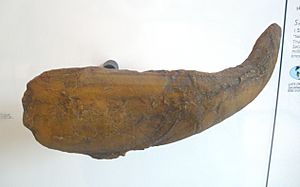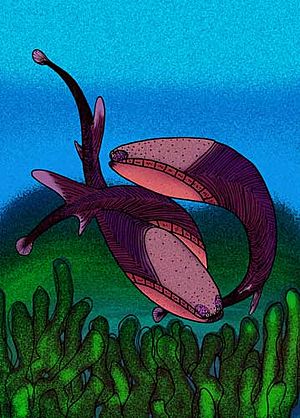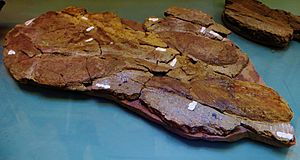Sacabambaspis facts for kids
Quick facts for kids Sacabambaspis |
|
|---|---|
 |
|
| Sacabambaspis fossil | |
| Scientific classification |
|
| Kingdom: | Animalia |
| Phylum: | Chordata |
| Superclass: | Agnatha |
| Class: | †Pteraspidomorphi |
| Family: | †Sacabambaspidae |
| Genus: | †Sacabambaspis Gagnier, Blieck & Rodrigo, 1986 |
| Type species | |
| †Sacabambaspis janvieri Gagnier, Blieck & Rodrigo, 1986
|
|
| Species | |
|
|
Sacabambaspis was an amazing, ancient fish that lived a very long time ago, during a period called the Ordovician (about 461 to 450 million years ago!). It's now extinct, meaning it no longer exists. This fish didn't have jaws, which is pretty unusual!
It liked to swim in shallow waters along the edges of a huge ancient continent called Gondwana. We know a lot about Sacabambaspis because many of its fossils have been found. It's also related to another ancient fish called Arandaspis.
Contents
What Did Sacabambaspis Look Like?
Imagine a fish about 25 centimeters (10 inches) long – that's how big Sacabambaspis was! Its body looked a bit like a tadpole. It had a very large head, a flat body, and a tail that wiggled.
One of the most interesting things about Sacabambaspis was its eyes. They were placed far forward on its head, almost like the headlights on a car!
Its Amazing Armor
Sacabambaspis had a special head shield that acted like armor. This shield was made of a large plate on top (called the dorsal plate) and a deep, curved plate underneath (called the ventral plate). These plates were decorated with cool, oak-leaf or tear-drop shapes.
Narrow plates connected the top and bottom parts of the shield along the sides. These side plates covered the fish's gill area. Its eyes were very far forward on its head. Between its eyes, there might have been two small nostrils. The rest of its body, behind the head shield, was covered with long, strap-like scales.
Its Unique Tail
The tail of Sacabambaspis was also special. It had large upper and lower parts, and a long, flexible rod (called a notochordal lobe) that went into the tail. The very end of this rod had a small fin.
This tail was different from other ancient fish called heterostracans. Their tails often looked symmetrical and were supported by strong bones.
Where Was It Found?
The name Sacabambaspis comes from the village of Sacabamba in Bolivia. This is where the very first fossils of this fish were discovered.
- S. janvieri is the main type of Sacabambaspis. About 30 fossils of this species were found in Bolivia, all in a small area. Scientists think they died suddenly, perhaps from a flood of fresh water after a big storm. They were found with many ancient clam-like creatures called brachiopods, which also died at the same time.
- Other types of Sacabambaspis have been found in Central Australia and Argentina.
- Fossils were also discovered in Oman, on the Arabian Peninsula. These discoveries showed that Sacabambaspis lived all around the edges of the ancient continent of Gondwana, not just in the southern parts like South America and Australia.
How It Lived
What Did It Eat?
Even though Sacabambaspis didn't have jaws, its mouth was lined with almost 60 rows of small bony plates. These plates could probably move. This movement helped the fish create a strong suction to pull in food. It could expand and contract its mouth and throat to suck in its meals!
How It Sensed Its World
Fossils of Sacabambaspis show clear signs of a special sensory system called a lateral line system. This system is a line of tiny pores. Inside each pore are nerve endings that can feel small movements in the water.
This allowed the fish to detect things like predators swimming nearby. The way these organs were arranged in lines helped Sacabambaspis figure out the direction and distance of any disturbance in the water.
See also
 In Spanish: Sacabambaspis para niños
In Spanish: Sacabambaspis para niños




